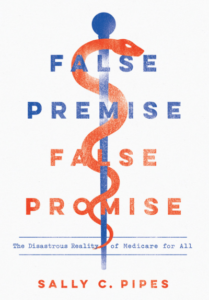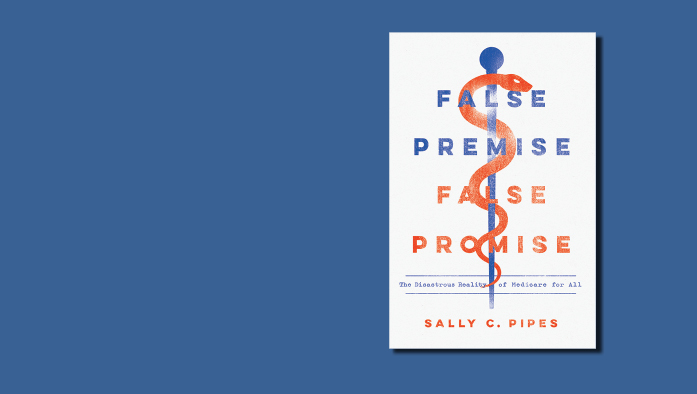Below are remarks delivered by PRI President, CEO, and Thomas W. Smith Fellow in Health Care Policy Sally C. Pipes at the annual national meeting of the Adam Smith Society on June 9, 2021. She spoke about free market health care solutions.
Thank you so very much for inviting me to give my third address to the Adam Smith Society. It is always a pleasure to speak to your members, even if virtually!
We’re here to discuss free-market healthcare solutions, and I can’t think of a better time to do so. Our experience with COVID-19 over the past 15 months has made clear the dangers of letting bureaucrats stifle innovation and meddle in Americans’ lives.
Consider the federal government’s decision to “pause” the Johnson & Johnson vaccine for 10 days in  April after six people who received the shot developed rare blood clots.[1]
April after six people who received the shot developed rare blood clots.[1]
At the time, nearly 7 million people had been “jabbed” with the vaccine. The chances of developing blood clots were literally one in a million.[2]
But according to a Kaiser Family Foundation poll conducted at the end of April, during and after the pause, less than half of Americans said they had confidence in J&J’s vaccine. One in five who had not received a shot said the pause changed their mind about getting one.[3]
The average daily rate of vaccinations peaked three days after the pause and has not yet recovered, even though less than half the population has received a full course of shots.[4]
Along with the Pfizer and Moderna vaccines, the J&J shot represents a triumph of biopharmaceutical innovation.
Unfortunately, regulators will do anything to protect their jobs and guard against bad press, even if it means putting American lives at risk.
Regulators could see the vanishingly small share of people who suffered side effects because of J&J’s vaccine. They could not see, they could not conceive of, the many, many more people who may have become sick or died while waiting for a shot.
And by sowing doubt in COVID-19 vaccines more broadly, federal regulators put millions more people at risk — and slowed our collective effort to put this pandemic behind us.
The vaccine debacle illustrates that American health care works best when the government intervenes least. By rolling back regulation, leveraging the power of market competition, and encouraging consumer choice, we can bring about better health care at lower cost.
Let’s start by looking at the challenges to restoring market principles to health care. Democrats have their eyes on putting the federal government in charge of an increasingly large share of the healthcare market.
The most extreme manifestation of this vision is Medicare for All. Senator Bernie Sanders’s preferred brand of healthcare reform was reintroduced on March 17, 2021, by Democratic House members Pramila Jayapal and Debbie Dingell.[5]
 Their bill would abolish private insurance and enroll every American in a government-run health plan within two years.[6] [7]
Their bill would abolish private insurance and enroll every American in a government-run health plan within two years.[6] [7]
Medicare for All would have a monopoly on covering everything from hospitalizations to doctor visits to prescription drugs.[8] The price tag would be hefty — as much as $60.7 trillion over a decade.[9]
Of course, the government need not take over the entire health insurance sector to undermine markets in health care.
Take the much touted public option that presidential candidate Biden campaigned on. Nearly seven in 10 voters favor a public option, wherein the government would charter a publicly-funded health plan to compete against private insurers.[10]
Several leading congressional Democrats have announced plans to draft legislation that would establish a federal public option because President Biden has not included it in any of his economic recovery plans.
On May 26, Patty Murray, the chair of the Senate Health, Education, Labor, and Pensions Committee, and Frank Pallone, the chair of the House Energy and Commerce Committee, issued a public request for information on what a possible public option bill might look like.
A number of states — including Colorado, Connecticut, Nevada, and Oregon — have tried or are trying to launch their own public health plans.
Only Washington state has done so thus far. But its plan has struggled to take root. It’s had to set premiums higher than private plans because of the generous benefits package the state ordered it to cover. Doctors and hospitals have been reluctant to participate, given the public option’s low reimbursement rates.[11] Washington’s lawmakers plan to overcome that reluctance by ordering them to participate moving forward.[12]
A federally chartered public option would have several distinct advantages over private plans — and state plans, for that matter. It would have the power to pay doctors and hospitals below-market rates, like Medicare and Medicaid do. And it wouldn’t have to cover its costs, given its direct line to the federal Treasury. So it would be able to set its premiums at artificially low levels — and underprice private insurers.
Consumers would understandably respond by dropping their private coverage and switching to the public plan. That exodus would drive private insurers from the market. One study found that three decades after the establishment of a public option, 70 percent of states wouldn’t have a private plan on their insurance exchanges.[13] This is a “stepping-stone” approach to M4A.
Friends of markets must do more than stand athwart the health policy debate, yelling stop. We must articulate what we’re for.
One thing we can be “for” is increasing the supply of care.
Health costs have been rising for decades. That’s partially a function of increasing demand. The population is aging, and older people need more care than younger people. It’s also a function of rising wealth. As people get richer, health care becomes a more appealing service on which to spend.
If we boost the supply of care, we’ll alleviate some of the forces that have pushed up its price.
Repealing certificate of need laws is one way to increase the supply of care. These measures require hospitals to seek permission from the government to expand their facilities or build new ones. In effect, they allow incumbent healthcare providers to lobby to keep out competitors. Data from the Kaiser Family Foundation show that per-capita health expenditures are 11 percent higher in states with certificate of need laws than in those without.[14]
Expanding the use of telehealth is another way to boost the supply of care.
Consider someone in rural America. The nearest hospital may be miles away. Visiting a specialist may be a daylong affair. Telehealth can bring top-notch care into rural communities via video feed.
COVID-19 has made many more Americans comfortable with telemedicine. They had to be; in many cases, they weren’t allowed to leave their homes. Telehealth claims increased over 4,000 percent from March 2019 to March 2020.[15] Over 80 percent of Americans say they’ll want to use telehealth after the pandemic subsides.[16]
To meet this new demand, many states relaxed restrictions on telehealth for the duration of the public health emergency. Lawmakers should make those relaxed standards permanent.
They can start by allowing doctors to treat patients virtually across state lines and eliminating requirements that patients visit a doctor in person before having a telehealth visit.[17]
Lawmakers can also alter reimbursement structures so physicians get paid the same amount for virtual visits as they do for in-person visits.[18]
Congress has expressed interest in ideas like these. In late May, lawmakers in the House introduced a bill that would allow Medicare beneficiaries to keep receiving audio-only telehealth services. Legislation pending in the Senate would direct the federal government to come up with a list of telehealth services Medicaid and the Children’s Health Insurance Program must cover.[19]
Another way we can boost the supply of care is by relaxing licensing restrictions and scope of practice laws covering NPs and PAs.
The United States currently has 290,000 nurse practitioners, 90 percent of whom specialize in primary care.[20] NPs hold graduate degrees and have advanced medical training.[21] [22]
Some states restrict the “scope of practice” for NPs and physician’s assistants. They may be barred from delivering care or prescribing drugs without the oversight of a physician.
Many of these restrictions can go. NPs and PAs are well-suited to independently handle plenty of primary care cases that have historically been the province of physicians.
Delegating more to NPs and PAs would free up doctors for more complicated cases and have the effect of increasing the supply of physicians.
We certainly need them. The Association of American Medical Colleges projects that the United States will be short 139,000 doctors by 2033, including more than 55,000 primary care physicians.[23]
To narrow this shortage further, we can shorten the amount of time it takes to become a doctor. For some time, would-be doctors have had to endure four years of undergraduate study, four years of medical school, and three to seven years in residency and fellowship.[24]
Studies have shown that the fourth year of medical school is largely unnecessary, and three-year medical programs are on the rise.[25] [26]
We should also create a freer labor market for doctors. Every state maintains its own licensing regime, with its own set of fees and requirements. That system locks doctors in place and prevents them from going where their skills may be in higher demand.
Currently, 29 states and the District of Columbia have signed onto something called the Interstate Medical Licensure Compact, which essentially allows physicians licensed in one member state to practice in any other.[27] Holdout states should follow suit.
A freer labor market would also enable physicians trained abroad to practice unencumbered in the United States. Those here on H1-B visas are only allowed to practice at the facility sponsoring them. As a result, our country has 10,000 qualified, working doctors who can’t volunteer at a clinic or a COVID vaccination site.[28]
Physicians who were educated and practiced in other countries must redo their training by completing residencies in the United States if they wish to practice here.[29]
That’s nearly impossible, given how few residencies there are. More than 44,000 applicants — mostly new medical school graduates — vie for 37,000 residency slots.[30]
Because of these onerous requirements, skilled foreign physicians are doing jobs that are not related to their training as doctors.
No free-market vision for healthcare reform would be complete without a plan to empower patients. The best way to do that is by expanding access to tax-advantaged health savings accounts, or HSAs, and health reimbursement arrangements, or HRAs.
HSA-owners can set aside up to $3,600 each year tax-free. Families can contribute up to $7,200 annually in pre-tax income.[31] [32] The contents of the accounts grow tax-free, and withdrawals for qualified health expenses are also tax-free.[33] People own their HSAs, too; they can take them from job to job. Unfortunately, they have to be combined with a qualified high deductible health care plan.
At age 65, an HSA becomes a retirement account. A beneficiary can dip into it for non-healthcare expenses.[34] It is illegal for Medicare benificiaries to contribute to an HSA. This needs to be changed.
HRAs are similar, but they’re sponsored by employers, who decide how much money to set aside for each worker. Individual employees then apply for tax-free reimbursement for insurance premiums or medical expenses.
HRAs are like 401(k)-style defined contribution plans for employee health care. Employees control their own healthcare dollars; they’re not stuck with whatever plan their employer picks for them. The only catch is that they can’t carry their HRAs from job to job.
Prior to 2020, HRA funds could not be used to purchase individual health insurance. The Trump administration changed that and projected that some 11 million people might eventually take advantage.[35]
Imagine what American health care would look like if everyone had access to an HRA or HSA and could spend the proceeds as they saw fit.
People would have an incentive to shop for value in health care like they do in every other sector of the economy. They could take advantage of new federal rules requiring hospitals to publish their previously secret prices.[36]
Injecting a dose of consumerism into the healthcare market would prompt hospitals and doctors to compete for patients’ business by cutting prices, improving quality, and offering appealing new services.
Big government advocates say it’s impossible to have a free market in health care. But a year ago, everyone thought it was impossible to develop a safe and effective COVID-19 vaccine in under a year — let alone three!
When we minimize government intervention in the market and let private companies and individuals flourish, there’s no limit to what’s possible. I know it. You know it. Adam Smith knew it in 1776 when he wrote The Wealth of Nations.
The only people who don’t seem to know it are the politicians and bureaucrats in Washington and at the state level. They look at more than a half-century of failed government intervention in the healthcare space and think we need more of it.
Which brings us back to Johnson & Johnson. When the FDA paused the vaccine distribution, it gave us a glimpse at two paths we could take.
The first path is forged by boldness and innovation. It’s the path that will lead us out of the COVID-19 pandemic — that will empower individuals and yield advances in medicine.
The second path is grown over with incompetence and hesitation. It’s the path that stopped vaccine rollouts in their tracks — that will lead to higher taxes and more government intervention.
To paraphrase my mentor Milton Friedman who wrote the foreword to my first book Miracle Cure: How to Solve America’s Health Care Crisis and Why Canada Isn’t the Answer, we are free to choose which path we’ll take.
It’s up to you, the members of the Adam Smith Society, to lead the American people down the right path and into a free, healthy future.
I look forward to your questions and to what I am sure will be an engaging and productive conversation.

